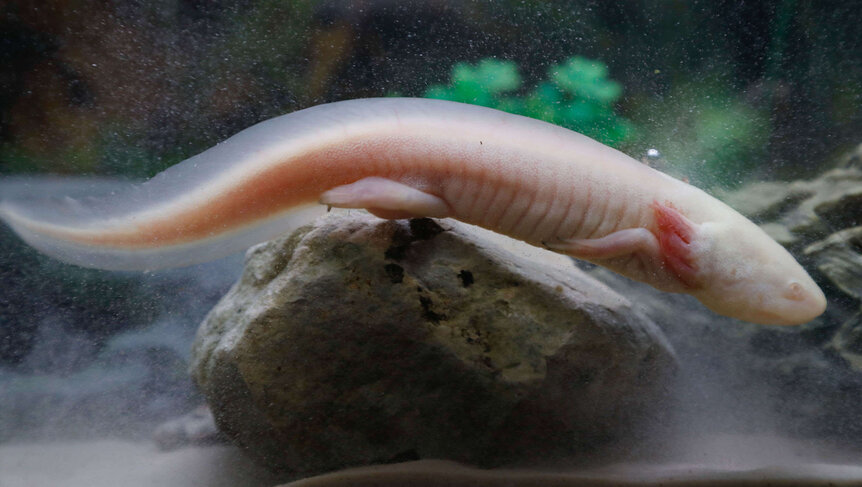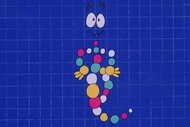Create a free profile to get unlimited access to exclusive videos, sweepstakes, and more!
Axolotls can teach us how to morph and regenerate like Pokémon

Though the axolotl looks more like Wooper (the Water/Ground-type Pokémon who was actually inspired by it), this self-regenerating salamander can undergo its own Eevee-lution.
You don’t need a Pokéball to catch one, but something else about the axolotl has had scientists in gotta-catch-‘em-all mode: its genes. Axolotls can regenerate limbs and even vital organs — something humans are incapable of outside a video game. While we won’t be regrowing entire arms or organs anytime soon, the axolotl’s genome could give us some serious cheat codes for regrowing tissue. Now a team of scientists have expanded on previous genomic sequencing they had done and revealed even more about its biological gameplay.
Geneticist Jeremiah Smith, whose team had previously sequenced the axolotl genome, and who recently leveled up that work in a study of that genome published in PNAS, hopes that this DNA can someday be used to turn fiction into science.
“By improving our understanding of the locations of genes in the genome and long stretches of DNA that lie between genes, we are beginning to understand the rules that dictate when and where genes are turned on during development, regeneration, and other processes,” Smith told SYFY WIRE.
Axolotls evolved the ultimate life hack. They can morph and regenerate. What is especially weird about the axolotl is that it tends to keep its juvenile morphology, which explains the fringe gills and a tail that looks something like a tadpole’s. The morphing is also encoded into their genes, because they are related to tiger salamanders, many of which metamorphose from their juvenile to adult form. Some of them can even choose not to (paedomorphosis). Axolotls beat that because they rarely transform at all in adulthood, though some test subjects that were fed thyroid tissue morphed automatically.
The axolotl actually gets bonus points for this. Because it normally doesn’t metamorphose, it can (like most non-morphing species) get the most out of a stable underwater habitat and whatever food might be there. As to how axolotls got that almost indecipherable DNA, salamanders have large genomes to begin with.
“The large genomes of salamanders seem to trace back to a period of their ancient evolutionary history, maybe 200 million years ago, when selfish DNA elements were able to make multiple copies of themselves and insert throughout the genome,” Smith said.
Selfish DNA is exactly what it sounds like. It copies itself over and over again through a genome without having any effect on reproductive success; it may or may not be a detriment to reproduction. While DNA will duplicate itself many times over as any organism evolves, some freaky sort of glitch must have given axolotl DNA a boost. Those copies inserted into the genome kept evolving further with salamanders and probably ended up being useful enough to keep around. Of course, that means all that extra genetic information remained stashed in their genomes.
The question is whether the elements of DNA that give axolotls their regenerative abilities can be incorporated into humans. Smith believes that science will keep evolving just like the salamander.
“Right now, what we are trying to do is find the specific sequences that are important for the functions we are interested in, like regeneration or metamorphosis,” he said.
Our DNA strands are five times smaller than those of anything that looks like Wooper or Charmander. If we want to reprogram human cells to regenerate like these amphibians, we shouldn't expect super-salamander genes right away. Just one protein in an axolotl’s DNA can have hundreds of thousands of base pairs, or duos of nucleotides that bond to form the rungs of the “ladder” in the double helix. Going beyond the mapping of the axolotl genome that they had done before, Smith and his team needed to put millions of base pairs together into billions and billions.
Will we ever transcend reality to pull a Pokémon? It could happen. It will take more than just injecting someone with axolotl magic. We already have the potential for regeneration built in. With such a huge difference between human and salamander DNA, the transformation will be gradual and probably start out as medications that can manipulate human cells into regenerating, which could mean wounds healing on their own and fewer organ transplants in the future.
“Translating that information to human has been more challenging,” Smith said. “It seems reasonable to expect that some discreet regulatory elements might be found that could improve the response of cells to injury. It could be possible within our lifetimes.”
The only thing we need now is something that can give us a Gigantamax transformation.















